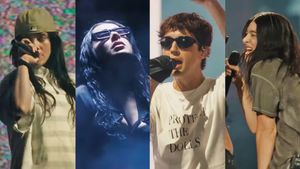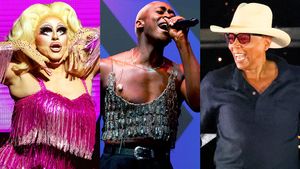Shh! I have a dirty little secret. I am an unabashed Pretty Little Liars superfan, but I haven't always been out about it. Where once I dissembled about my love of the twisting, turning, nearly impossible-to-follow mystery series about five teen girls bullied by an omniscient cyberstalker in a black hoodie, couching my adoration for the show in academic theory about the series' creative nods to films from Alfred Hitchcock to the French New Wave, I've learned to simply own that I'm a middle-aged fangirl.
To be sure, the series on Freeform (formerly ABC Family), now airing its final 10 episodes, from out creators Marlene King and Oliver Goldstick, teems with classic film and literary references that serve to enhance the plot and to add a satisfying layer for viewers who catch the homages. But beyond the insanity of a story that has Emily, Hanna, Spencer, Aria, and Alison often bedecked in couture dresses and impossibly high heels running through woods to escape their bully A's various clutches and lairs, the show has always been full of heart regarding the various journeys of its protagonists.
Although the entire pretty package of the slick series pulled me in, it was Emily's heartrending and ultimately triumphant coming-out story over several episodes during the show's first season that kept me. PLL helped me realize that although I lived through the dawn of new queer cinema, Ellen DeGeneres's coming-out, and The L Word, I still felt a void from growing up when there wasn't a single lesbian or bisexual character on television. The teenage me, grappling with my sexuality, longed for validation that PLL and teen shows with queer characters since retroactively provide.
When I was a burgeoning lesbian growing up in suburban Connecticut in the 1970s and '80s, there were simply no female queer characters, let alone couples, on TV that I could identify as something I might want in my life. Looking back, I know I watched TV silently thinking but never vocalizing that Valerie Bertinelli on One Day at a Time was "so cute," or that Susan Dey on The Partridge Family was "so pretty" -- both truths in their own right and also signs of things to come for me.
Toward the late '70s, Tuesday became my favorite night for television because it was Laverne & Shirley night. They were women who shared not only an apartment but a bedroom, and despite their frequent tiffs and relationships with various guys over the years, they always circled back to their deep, abiding love for each other. It would be decades before I could articulate that the image of Laverne and Shirley peering longingly together over the bottles at Shotz Brewery resembled the closest thing to something I wanted for my life up to that point. A few years later The Facts of Life premiered, and the magnetic, often fraught tension between sassy rich girl Blair and the bad girl tomboy Jo that played out at a posh girls' boarding school resonated for me in then indescribable ways.
Because I skipped over Buffy the Vampire Slayer in the late '90s, stupidly assuming it was teen schlock with monster makeup, there were two full decades between when the teenage me identified with The Facts of Life's Jo, parrying with and confiding in Blair in increasingly intimate ways, and when I first encountered queer teen representation on TV. I'd already fallen headlong for The L Word in 2004, gaping holes in the plot and awful stereotypes and all, when I arrived at South of Nowhere (2005), the N's (Teen Nick's) drama about Spencer, a sweet girl who moves to Los Angeles and falls for her school's bad girl, Ashley. Their epic on-again, off-again relationship was the first I'd seen that painted a portrait of what my teen life might have resembled if only I could have been out about the exhilarating and completely terrifying secret affair I had when I was 16 with a senior girl that heated up during rehearsals for our high school production of Godspell.

Spencer and Ashley in South of NowhereOf course, there were other teen shows before South of Nowhere that I missed. Bisexual actress Evan Rachel Wood played a teen who came to grips with her sexuality on ABC's Once and Again, which predated South of Nowhere, and there were various incarnations of Degrassi that featured queer characters. Glee premiered in 2009, but Santana's coming out-story postdated Emily's on PLL.
South of Nowhere was the first teen show I'd seen that depicted an open female relationship I never knew was possible back when that senior girl and I confessed our most intimate thoughts on abandoned back roads in our tiny town, kissing across the stick shift of her Volkswagen Rabbit because we had nowhere to go without fear of getting caught. But PLL, with its enthralling central mystery, the show's creators' reverence for cinema -- with homages to several Hitchcock films, Italian director Michelangelo Antonioni's Blow-Up, and Otto Preminger's classic Laura -- and with not only Emily's coming-out story, but later, her girlfriend Paige's, hit all of the right notes for me. It wasn't long into my obsession with the series before a friend who works at Warner Bros., where the show was filmed, sent me an autographed photo of the liars. I didn't ask for the photo and I initially felt a little silly displaying my picture signed by its stars Mitchell, Troian Bellisario, Ashley Benson, and Lucy Hale. But now it occupies a place on my office wall where I've bared all of my adult preoccupations, hanging beside a poster of Lena Hall in Hedwig and the Angry Inch and across from a poster of Cate Blanchett and Rooney Mara in Carol.
Since PLL began seven years ago, I've been an ardent viewer of several other teen shows with queer storylines for women, including MTV's short-lived Faking It, in which teen girls pretend to be lesbians in order to be cool at their uber-progressive high school, but after a kiss for show, one of the friends embarks on an exploration of her identity. The CW's The 100, with its post-apocalyptic world and fierce women, including a bisexual lead who falls for a lesbian warrior, had immediate appeal. I went back and righted the wrong that was my eschewing of Buffy, having failed to realize that not only was there a benchmark female relationship between Willow and Tara, but the series was so artfully ahead of its time that it even based an entire episode on auteur filmmaker Luis Bunuel's Exterminating Angel. While Glee, with its musical numbers and inherent queer and camp sensibility was already a shoo-in for me to love, Santana's coming-out story tapped right back into my longing to envision what being out in high school might have looked like.

Years ago, I found myself attempting to explain away how a soapy teen show about a clique of unrealistically attractive high school-age girls became my favorite obsession, its themes of friendship, loyalty, first love, and acceptance notwithstanding. But I've since embraced the notion that PLL helped me identify my ongoing longing for representation, and that after all of the queer-themed films about adult women coming out that I've seen throughout my lifetime, I still crave a thoughtful teen coming-out story to fill in the gaps of representation from when I was in high school navigating my sexuality. Now, rather than rationalize my love for the series, I hunker down on my couch on Tuesday nights shouting things like "Run, Emily!" and "Get the hell out of there, Spencer" at my television, and I'm absolutely OK with it.





















































































Fans thirsting over Chris Colfer's sexy new muscles for Coachella